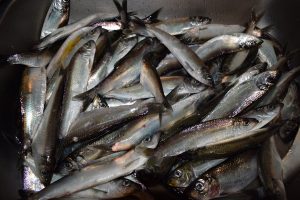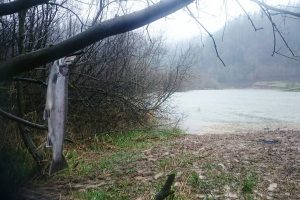
• Largemouth and smallmouth bass are popular warmwater fish
• Fishing technique is similar for both bass varieties
Oregon is well known for a variety of bass species including the most popular - largemouth and smallmouth bass. Bass fishing is definitely an activity that you shouldn't miss if you are a fishing enthusiast. But the only way you can make your fishing trips worth your time and effort is to ensure you are at the right place and doing everything correctly in order to catch bass.
Successful bait fishing takes more than just tossing out the bait and then waiting for the fish to bite. You definitely need to use the best bass fishing techniques and also understand fully what it takes to catch this fish. Here are some tips to help make your bass fishing trips a big success.
Largemouth Bass
Largemouth bass is characterized by a white belly and greenish back with a dark stripe stretched along the sides in the middle. The one distinct feature that gave this fish its name is a large mouth with an extended jaw. In Oregon, largemouth bass can weigh up to 12 pounds and be as long as 25 inches or more.
Young largemouth bass eats zooplankton and later progresses to insects until it is large enough to eat smaller fish as well as crayfish. Largemouth bass can be generally found at the backwater sloughs of rivers or at shallow lakes and ponds.
Smallmouth Bass
Smallmouth bass ranges in color from bronze to golden green with vertical lines and patches along its sides. Unlike largemouth, smallmouth doesn't have an extended jaw and it is smaller than its counterpart. In Oregon, smallmouth bass can weigh over 7 pounds and grow up to 23 inches long.
Young smallmouth bass eats zooplankton and later progresses to insects until it is large enough to eat smaller fish as well as crayfish. The fish can generally be found in warm rocky streams with deep holes or at lakes with rocky shores.
Always check for up-to-date regulations for size and catch restrictions since those tend to change from time to time.
Best Time and Places to Catch Bass
Knowing how to locate and find bass can boost your chances of catching bass each time you go for your fishing trip. Even if you know of a place with a lot of fish, you might not catch it if you don't know the exact spots they are hiding in the water.
If you go fishing in a river, try casting your fishing trap along the riverbank. In most cases, the bass is there splashing around or seeking cover. If you are fishing in the reservoir or lake, try casting along the shoreline moving to deeper depths.
Fish at the Right Time
Largemouth and smallmouth bass may be caught most of the year but if a temperature of the water is below 50°F, bass are less active and therefore catching it more difficult. As the water warms to 60°F bass moves to shallow water to spawn. Following ancient instincts, males aggressively guard nests and fry, striking everything that moves around.
Because bass avoid bright light and summer heat, the best time to go for bass fishing is during the first early hours of the day, or during the last hours towards the evening. At these times of the day, the bass is usually out looking for food at the surface of the water.
Bass is somewhat smart and curious. A fish will take off as soon as it notices someone is out there trying to catch it. Even when in abundant supply, you may end up catching nothing if you scare bass away. Therefore, vary up your retrieve speed to be able to catch more bass.
Fishing Techniques
When it comes to bass fishing, a technique used can mean the difference between success and failure. Regardless of whether you are a professional or an amateur angler, using the right fishing techniques can boost your chances of catching more bass. Here are some of the best fishing techniques you can use.
Topwater
This is one of the best bass catching techniques. It entails using a topwater bait, thus making it an extremely easy technique for luring and catching those hungry and active bass on the surface of the water. The technique is meant to get the attention of the fish using dramatic movements and noise. Some of the best topwater baits include poppers, frogs, and jitterbugs.
Pitching and Flipping Technique
This is the best technique to fish when the bass isn't active and hiding in thick cover. With this technique, you can get even the smallest bass hiding in the shallow-water thick cover devoid of spooking them too much. This technique is best used with a 6 to 7 foot fishing rod, together with a soft-plastic bait.
Jerkbait
This is the simplest bass fishing technique that is excellent for novice anglers. It entails using a bait that closely resembles a prey fish, and then jerking the rod tip as you reel, so as to give the bass an impression of an easy meal. This technique is best used in clear water where fish can see the bait easily.
Bass Fishing Locations
A few bass fishing locations known for their high populations of largemouth and smallmouth bass are listed below.
Crane Prairie Reservoir
Crane Prairie Reservoir boasts one of the largest populations of bass in Oregon, thus making it an excellent place for bass fishing. The ample supply of food in the form of vegetation and timber makes it a heaven for bass. Today, it boasts the largest populations of largemouth bass than any other place across the state.
Prineville Reservoir
Prineville is a fantastic location to catch largemouth and smallmouth bass as well as crappie and brown bullhead fish. The smallmouth bass is present at much larger amounts at the reservoir than the largemouth bass. The typical Prineville largemouth bass can weigh over 2 pounds.
Columbia River
This is one of the best places to go for long-distance bass fishing tours. It has a huge population of smallmouth bass alongside other unique species of bass.
Tenmile Lakes
Located on the South Coast of Oregon between Reedsport and Coos Bay, North and South Tenmile Lakes are popular among bass anglers. The lakes feature ultra-clear waters, thus making it quite easy to view the fish from your boat.
The local fishermen here can give you valuable advice helping you to catch some of the largest largemouth basses. Typically, bass range from 1 to 4 pounds. The lakes are known as a site of numerous bass tournaments.
You May Also Like








